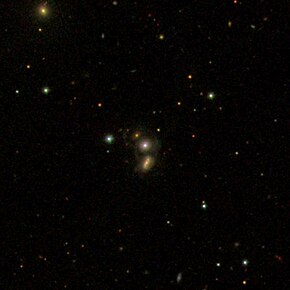IC 1166 are a pair of galaxies in the Corona Borealis constellation[1] comprising IC 1166 NED01[2] and IC 1166 NED02.[3] They are located 977 million light-years from the Solar System[4] and were discovered on July 28, 1892, by Stephane Javelle.[5]
| IC 1166 | |
|---|---|
 Sloan Digital Sky Survey image of galaxy pair IC 1166 | |
| Observation data | |
| Constellation | Corona Borealis |
| Right ascension | 240.53 degrees |
| Declination | 26.32 degrees |
| Redshift | 0.072080 |
| Heliocentric radial velocity | 20,818 km/s |
| Distance | 977 Mly (299.54 Mpc) |
| Apparent magnitude (V) | 16.77 and 19.08 |
| Surface brightness | 23 and 23.4 mag/arcsec |
| Characteristics | |
| Type | E and SBb |
| Size | 110,000 ly and 160,000 ly |
| Notable features | Interacting galaxy and Seyfert galaxy |
| Other designations | |
| IC 1166 NED01: PGC 56771, Mrk 867, 2MASX J16020888+2619456, SDSS J160208.91+261945.5, NVSS J160208+261942, KUG 1600+264, CGCG 137-018, IRAS 16000+2628, PGC 1772024, Mrk 867NIC 1166 NED02: PGC 1771884, UZC J160208.9+261929, 2MASX J16020881+2619316, SDSS J160208.82+261931.1, Mrk 867S | |
Galaxies
IC 1166 NED01
IC 1166 NED01[6] or PGC 56771[7] is a type E[7] elliptical galaxy.[8] Located above IC 1166 NED02, it has a diameter of approximately 110,000 light-years.[5] PGC 56771 has an active nucleus and it is classified as a Seyfert type 1 galaxy.[6] It has a quasar-like appearance, but its host clearly seen and presents two sets of emission lines which are superimposed on each other.[9] PGC 56771 is classified a Markarian galaxy (designated Mrk 867), because compared to other galaxies its nucleus emits excessive amounts of ultraviolet rays.[10] It has a surface brightness of 23.2 magnitude and, located at right ascension (16:02:08.92) and declination (26:19:45.60) respectively.[8]
IC 1166 NED02
IC 1166 NED02[11] or PGC 1771884[12] is a type SBbc[12] spiral galaxy.[13] Located below IC 1166 NED01, it has an approximate diameter of 160,000 light-years making it slightly larger compared to the other galaxy[5] and does not have an active galactic nucleus.[11] PGC 1771884 has a surface brightness of 23.4 magnitude and, a right ascension of (16:02:08.83) and declination (26:19:31.20).[13]